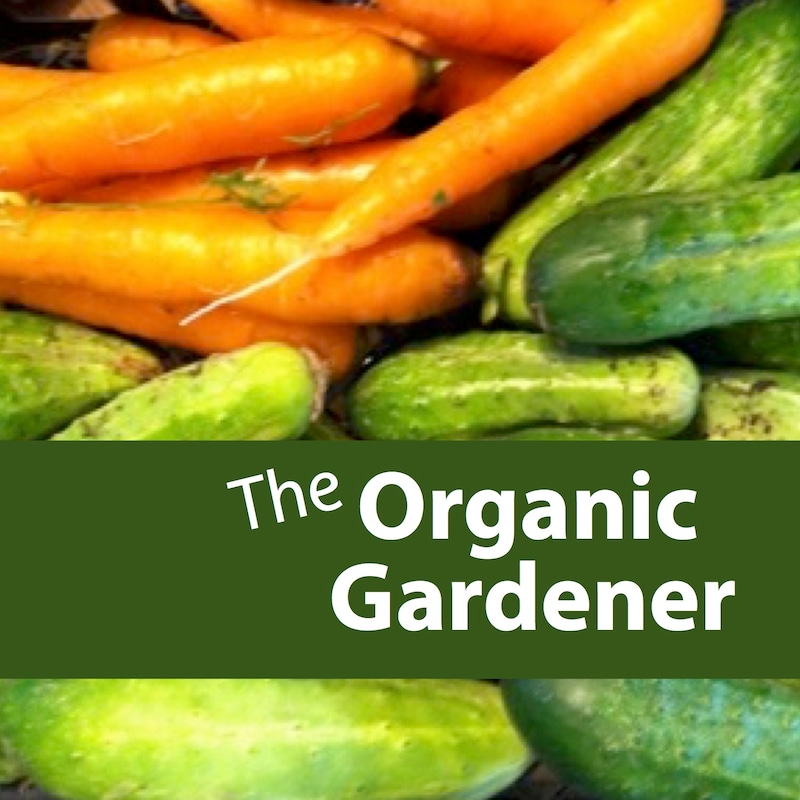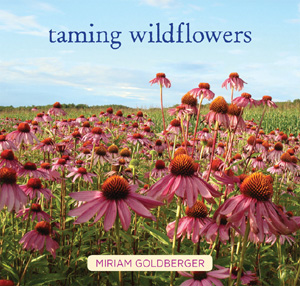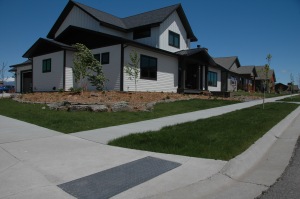
Shownotes
Replay of my interview that originally aired July 16, 2015. I thought it was good to do a bunch of landscaping episodes for Earth Day and the spring season!
Taming WildFlowers
Miriam Goldberger is the author of a new book that is not just informative but absolutely elegant called Taming Wildflowers.
Miriam and her husband Paul Jenkins have been tending the Wildflower Farm in Southern Ontario, Canada since 1988. They also developed Eco-Lawn which is a drought-tolerant, low maintenance turf grass that is grown at homes and businesses across North America.
which is a drought-tolerant, low maintenance turf grass that is grown at homes and businesses across North America.
Tell us a little about yourself.
I have been growing flowers since 1985, 1986, and Wildflower Farm was founded in 1988. I began by being captivated by the process of growing flowers from seed. It originally Wildflower Farm, back in the day it was a dried wildflower farm, then it morphed into Canada’s first pick your own flower farm and I had acres and acres of flowers, annuals and perennials not natives at that time to tend to. I became interested in wildflowers because they were low maintenance, I needed some gardens that weren’t for the pick your owns, that were for display that tended to themselves basically. So I researched the topic and found that perennials; North American Wildflowers and Native Grasses that are such low maintenance! It astounded me! Once they were established, they didn’t need to be watered, they didn’t need to be fertilized, they just took care of themselves they lived for a very long, long time.
So I put in some gardens, little gardens just to decorate the place that weren’t for pick your own. And people started asking me about the gardens, and they wanted us to landscape places at their gardens just like those gardens and they also wanted us to sell them wildflower plants. And we received so much interest in the wildflowers, the landscaping the plants, that eventually we succomed to the customers, and began to seriously study wildflowers and indeed became wildflower landscapers and started a native landscape nursery and destination point that was in existence for over 25 years!
And so I really learned a lot about wildflowers over the years, I learned how to grow native plants from seed, how to landscape with wildflowers either using only wildflowers or to incorporate flowers into an existent non-native garden. And also how to truly grow a wildflower meadow, the way most of us think the way wildflower meadows should be grown isn’t really the case, and it’s not a hard thing to do, but it is different then what you think it might be and then we also developed Eco-Lawn which is a low maintenance turf grass that really is such a great answer to drought problems and high maintenance expensive. There’s been a busy time, never a dull moment.
which is a low maintenance turf grass that really is such a great answer to drought problems and high maintenance expensive. There’s been a busy time, never a dull moment.
Well how do you grow a wildflower meadow? I guess you don’t just broadcast the seeds on to a pile of dirt?
There are a lot of people who ask: Can you just throw the seeds anywhere? Can I throw them on my lawn? Can I just throw them on my garden? If I throw them out into a ditch will they grow? Well, most of the time the answer is no, and there’s a few key reasons for that.
First of all, when most of us North Americans encounter seeds being sold, there in a big bag of seeds, with pretty pictures on it, or a can of seeds, or a pack of seeds and they’re usually not true North American wildflowers, most of the time they’re some random blend of European wildflowers, or not even wildflowers but plants from somewhere else that don’t tend to do well in here in the hot, very difficult conditions that we have through much of North America. If you and I happened to live in England where it rained a lot and they had this lovely perfect soil, and it’s much warmer then most parts of North America, then maybe so but here, we need to use the plants that have grown here successfully for many many thousands of years. And those are the North American Wildflowers that I specialize in.
We have so many extraordinary wildflowers and native grasses that work beautifully here. No matter what conditions you have in your garden there’s a wildflower that will thrive for you. Whether you have compacted clay, or you have beach sand, or gravel, or everything in between, whether your in the sun or the shade there are wildflowers that will work for you.
You were saying early there are some cool things on the Wildflower Farm Website and one of my favorites is the seed selector tool. You key in the conditions you’ve got, you can even put in what state or province your in, or what color flowers you want, what type of everything that you want or that exists at your place and Boom! You’ve got a list of native grasses and that will thrive in exactly your conditions! It’s very, very doable. These are all flowers and grasses that tend to live a long time and are tough customers and are very beautiful as well and just happen to make amazing cut flowers too!
Eco-Lawn
There’s a water savings calculator, which is on the Eco-Lawn pages, you just key in the size of your lawn, the amount of water, the number of times a week that you water.. And you can get a super quick calculation of how much money you will save by having an Eco-Lawn
pages, you just key in the size of your lawn, the amount of water, the number of times a week that you water.. And you can get a super quick calculation of how much money you will save by having an Eco-Lawn instead of a traditional shallow-rooted, very thirsty sod lawn.
instead of a traditional shallow-rooted, very thirsty sod lawn.
Eco-Lawn is a blend of 7 different fine fescue grasses. These are grasses that are the same kind of grasses that you find throughout much of North America when you go into the woods, and you see these beautiful rich green clumps of grass growing in the shade. We took 7 different kinds of these fine fescue grasses and created a blend that grows believe it or not in full sun, part shade, deep shade and even under pine trees. Eco-Lawn
is a blend of 7 different fine fescue grasses. These are grasses that are the same kind of grasses that you find throughout much of North America when you go into the woods, and you see these beautiful rich green clumps of grass growing in the shade. We took 7 different kinds of these fine fescue grasses and created a blend that grows believe it or not in full sun, part shade, deep shade and even under pine trees. Eco-Lawn has really deep roots that go down 9 inches in clay soil and 12-14 inches in a sandy, sandy soil and it has very fine blades and it’s wonderful to walk on barefoot. And because it has these deep roots, and fine blades, it’s need for water or nutrients is minimal, because it knows how to source them, itself. So that means you don’t automatically have to fertilize this lawn, there are occasional circustances where a top dressing of compost is a nice idea but in general this is a super low maintenance lawn that doesn’t need very much from you.
has really deep roots that go down 9 inches in clay soil and 12-14 inches in a sandy, sandy soil and it has very fine blades and it’s wonderful to walk on barefoot. And because it has these deep roots, and fine blades, it’s need for water or nutrients is minimal, because it knows how to source them, itself. So that means you don’t automatically have to fertilize this lawn, there are occasional circustances where a top dressing of compost is a nice idea but in general this is a super low maintenance lawn that doesn’t need very much from you.
Also if you go to our website with the Eco-Lawn in it you can also see that you can grow an Eco-Lawn
in it you can also see that you can grow an Eco-Lawn longer, you can leave it, because the blades are super fine, they actually fall over under their own weight, so an uncut Eco-Lawn
longer, you can leave it, because the blades are super fine, they actually fall over under their own weight, so an uncut Eco-Lawn only gets about 3½ -4” tall. It’s just luscious looking, just a rich emerald green, but there’s different ways to handle an uncut Eco-Lawn
only gets about 3½ -4” tall. It’s just luscious looking, just a rich emerald green, but there’s different ways to handle an uncut Eco-Lawn , we recommend just cuting it once or twice a year.
, we recommend just cuting it once or twice a year.
What’s also extraordinarily compelling about this lawn is that its quick to germinate but its slow to grow, which means that the average person is only mowing their Eco-Lawn once a month and it looks like a regular lawn!
once a month and it looks like a regular lawn!
Like I said there are Eco-Lawn in every province and state. They stay green once they are established and then there are people who have uncut Eco-Lawns
in every province and state. They stay green once they are established and then there are people who have uncut Eco-Lawns as well. There are Eco-Lawns
as well. There are Eco-Lawns on golf courses, they’re used in the roughs, they’re used in the non-putting green areas, quite extensively. It’s equisite looking, the other thing that’s really amazing, it actually crowds out weeds, it physically crowds them out. In 2 ways, one it grows in quite thickly, as it matures, and it also functions as its own weed killer. Here’s your word of the day, liliopathic, that means, it actually kills off it’s own contempetition as it germinates, so it kills off weeds.
on golf courses, they’re used in the roughs, they’re used in the non-putting green areas, quite extensively. It’s equisite looking, the other thing that’s really amazing, it actually crowds out weeds, it physically crowds them out. In 2 ways, one it grows in quite thickly, as it matures, and it also functions as its own weed killer. Here’s your word of the day, liliopathic, that means, it actually kills off it’s own contempetition as it germinates, so it kills off weeds.
As it matures it tends to crowd out most weeds. There are 2 ways to have an Eco-Lawn :
:
You can start from scratch with bear seed, and create a new Eco-Lawn . What a lot of people are doing is converting their existing high-maintenance, by overseeding in the spring and the fall, for several seasons, the amount of time it takes is how dense or patchy their existing lawn is, there are several factors but people do it all the time. It’s a great way to shift your lawn, there are times that there are particular plants that I’m not expert on that I pass on questions to my partner. So I’m not particularly aware of your knapweed, when I don’t know the specific info, but there are Eco-Lawn
. What a lot of people are doing is converting their existing high-maintenance, by overseeding in the spring and the fall, for several seasons, the amount of time it takes is how dense or patchy their existing lawn is, there are several factors but people do it all the time. It’s a great way to shift your lawn, there are times that there are particular plants that I’m not expert on that I pass on questions to my partner. So I’m not particularly aware of your knapweed, when I don’t know the specific info, but there are Eco-Lawn in Montana and everywhere you go.
in Montana and everywhere you go.
One of the coolest things, I’m particularly proud of with our company, we get emails and questions all the time from our customers, and we are always able to give them very technical accurate information so I can certainly get back to you or I can have my partner get back to you to make sure you are successful with whatever type of wildflower or Eco-Lawn project you’re working on.
project you’re working on.
People do tend to have lots of questions into it. After they look at the all the info on our website. There are pictures on the website, of different Eco-Lawns from customers and FB pages.
from customers and FB pages.
Let’s go back to the wildflowers.
The pollinators, every single one of them, all the birds , song birds, all the pollinators that exists has a very wonderfully compledx relationship with wildflowers, they co-evelolved together for thouseands and thousands of year. They really need each other. the wildflowers provide the best quilaity source of pollen and nectar, that we need to grow our human food, there have been some wondreful studies on how farmers who grow wildflowers have higher yeilds of their vegetable crops, and the quality of their crops is higher because these wildflwoers attract the beneficial bugs, that kill off the bad bugs that are harming the food crops so the farmers don’t need to use the massive quantities of pesticides on our foods! So wildflowers, aside from their enormous beauty, play extraordinarily important nutritional and economic rolls for us.
Ok, so this is all great. One of the things on the most basic level, somebody sitting around listening to this podcaast might want to know is how can I have wildflowers? Because it’s difficult to find wildflower plants in most nurseries. Most planst are hybridized, and not anywhere as useful nutrition for these important pollinators. The best way and most economical is to grow them from seed.
That is what we specialize in, there’s lots of info in my book and website.

My really imporatnt message, to people is it’s not hard to grow plants from seed. There’s a few different categories, talking in general growing plants from seed, not specifically wildflowers. There’s annuals which is stuff that has to hurry up and germinate and grow fast and produce flowers in the first year, those are most vegetables and some popular beautiful heritage annuals, like zinnias, and lineal and flowers in the mist. Which I still love, I don’t think anyone should only grow wildflowers, becasue they’re so many beautiful flowers.
Then there’s perennials right? Some don’t need to grow through the winter period “Sow and Grow” What’s cold moist stratefied, winter sowing, some seeds have hard shells, they need a processs where the shell can freeze and thaw, and freeze and thaw which breaks down the seed shell so it’s able to germinate. In the wild, seeds fall to the ground, the temps get high and low, the ground is very moist, that is their cue, once their shell softens, to start germinating. That’s all stratification is, it’s just a big fancy term for freeze/thaw.
There’s lots of ways to do that, you can just throw the seeds in the ground in the fall and let nature do it. You can do the same thing by putting seeds in the pot in then...







